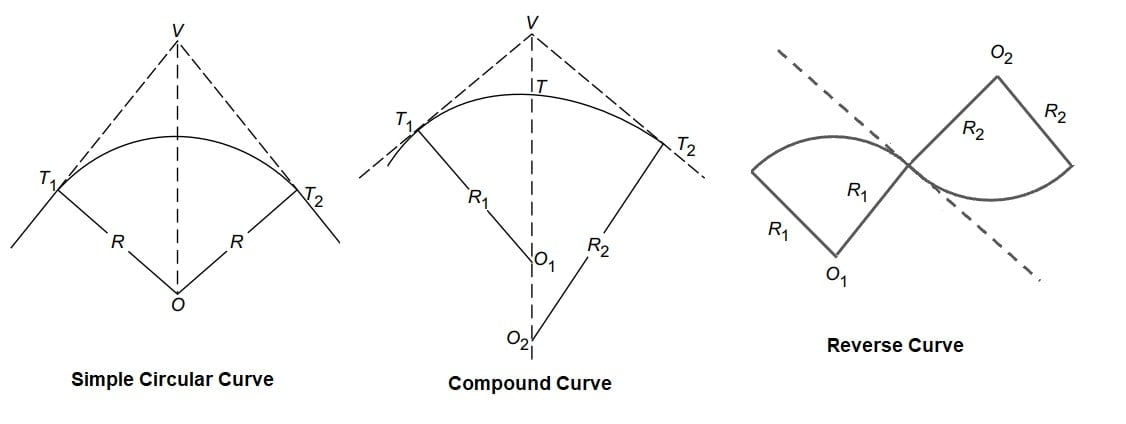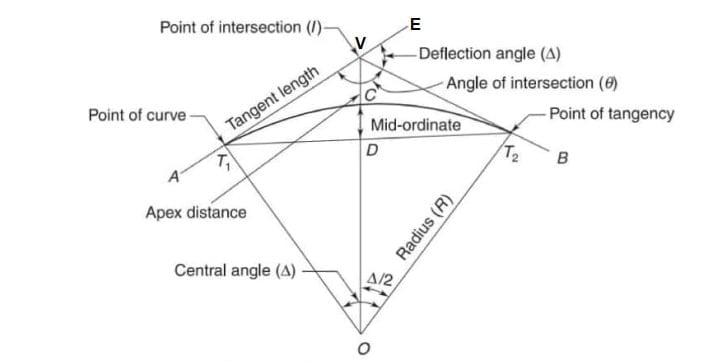Curve
- The curves are the transitions which are provided at the intersection of two straight lines.
- If curves are provided at the intersection of two straight lines in a horizontal plane it is termed as horizontal curve. And if it is provided at the intersection of two straight lines in a vertical plane it is termed as a vertical curve.
- Horizontal curves provided are generally circular, and vertical curves provided are generally parabolic.
Horizontal curves are generally of three types
- Simple Circular Curve
- Compound Curve
- Reverse Curve

Simple Circular Curve
A simple circular curve consists of an arc of the circle. This curve is tangential to two straight lines of the route.
Compound Curve
A compound curve consists of two circular arcs of different radius with their centres of curvature on the same side of the common tangent.
Reverse Curve
A reverse curve consists of two circular arcs (either of same or different radius) with their centres of curvature on the opposite side of the common tangent. Reverse curves are provided on the routes when the two straight lines are parallel or when angle between them is very small, for example hilly roads.
Note :
Compound and Reverse curves are provided for low speed, roads and railways.
Broken-back Curve

In the past, sometimes, two circular curves having their centres on the same side (Fig. 11.5) and connected with a short tangent length were used for railroad traffic. Since these are not suitable for high speeds, they are not in use nowadays.
Basic Definitions

Back tangent
The tangent line before the beginning of the curve is called the back tangent or the rear tangent. The line AT1 is the back tangent.
Forward tangent
The tangent line after the end of the curve is called the forward tangent. The line T₂B is the forward tangent.
Vertex or point of intersection
The back tangent and the forward tangent, when extended, intersect at a point called the vertex (V) or the point of intersection (P.I.).
Deflection angle
The angle VEB is called the angle of deflection (Δ).
Point of Curvature (P.C.)
It is the point on the back tangent at the beginning of the curve. At this point, the alignment of the route changes from a straight line to a curve. The point is also called the tangent-curve (T.C.) point. The point of curvature is also called the point of curve. Point (T₁).
Point of tangency (P.T.)
It is the point on the forward tangent at the end of the curve. At this point, the alignment of the route changes from a curve to a straight line. The point is also known as the curve-tangent (C.T.). Point (T₂).
Tangent distance (T)
It is the distance between the point of curvature (T) to the point of intersection (V). It is also equal to, the distance between the point of intersection to the point of tangency (T₂).
External distance (E)
It is the distance (VC) between the point of intersection (V) and the middle point C of the curve.
Long chord (L)
It is the chord of the circular curve. It joins the point of curvature (T₁) and the point of tangency (T₂)=T1DT2 .
Mid ordinate (M)
It is the distance (CD) between the middle point (C) of the curve and the middle point (D) of the long chord.
Length of curve (l)
It is the length of the curve (or route= T1CT2) between the point of curvature (T₁) and the point of tangency (T₂).
Elements of Circular Curve

Length of Tangent (T)
Length of Tangent (T) = T1V = VT2 = R·tanΔ/2
T1V = OT1·tanΔ/2 = R·tanΔ/2
VT2 = OT2·tanΔ/2 = R·tanΔ/2
Length of Curve (l)
Length of Curve (l) = T1CT2 = l
l = Δ × (π/180) × R, Δ is in degree.
And we know that
- Length of an Arc = Δ × R, where Δ is in radian.
- Length of an Arc = Δ × (π/180) × R, where Δ is in degree.
- Δ = Center angle of the arc
- R = Radius of the circle
Mid Ordinate (M)
Mid Ordinate (M) = CD
M = CD = OC- OD
\(M=R-Rcos\frac{\Delta }{2}\).
\(M=R(1-cos\frac{\Delta }{2})\).
\(M=R(versine\frac{\Delta }{2})\).
The mid ordinate of the curve is also called as the versine of the curve.
Length of Chord (L)
Length of Chord = T1DT2 =T1D + T2D
L = R·sinΔ/2 + R·sinΔ/2
L = 2·R·sinΔ/2
External Distance (E) Apex Distance
E = VC = OV-OC
{In triangle T1VO, cosΔ/2 = T1O/OC
secΔ/2 = OC/ T1O
secΔ/2 = OC/ R
R•secΔ/2 = OC}
E = R·secΔ/2 – R
E = R·(secΔ/2 – 1)
Chainage of Tangent points
Chainage at T1 = Chainage at V – length of tangent.
Chainage at T2 = Chainage at T1 + length of Curve.
Intermediate Chord Length
For 1st chord
C1 = {Multiple of chain length just greater than chainage at T1 – Chainage at T1 }
For 2nd to (n-1) chord
C2 = C3 = C4 ………= Cn-1 = {chain length= C}
For Last chord
Cn = {Chainage at T2– Multiple of chain length just less than chainage at T2 }
No of Intermediate Chord
\(n=[\frac{l-C_1-C_2}{\text{chain length}}+2]\)